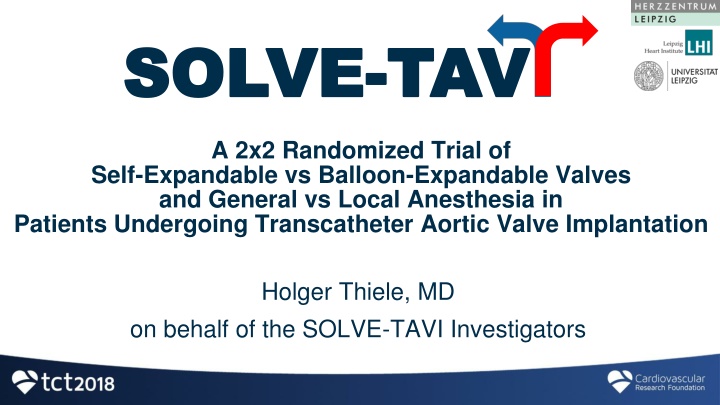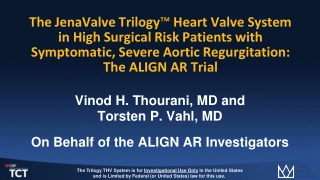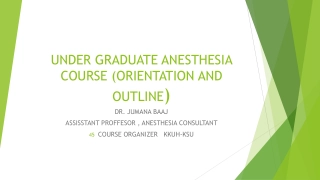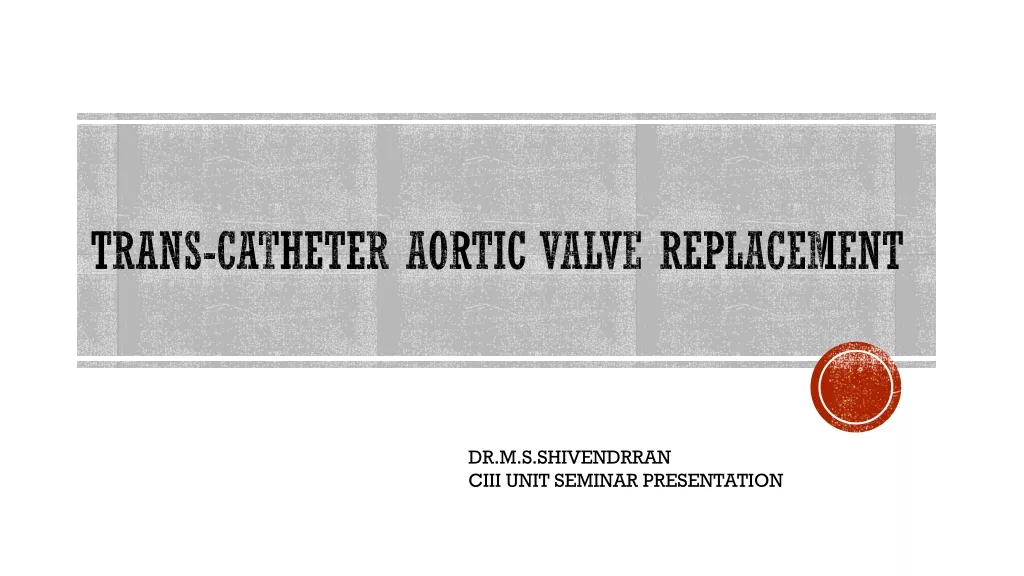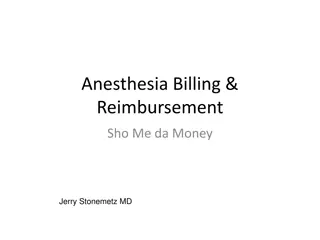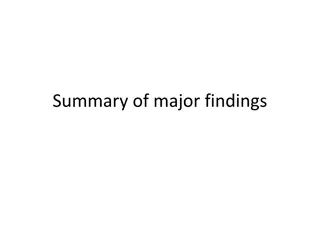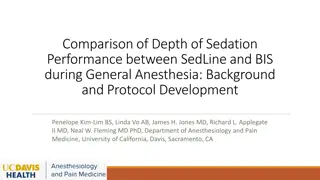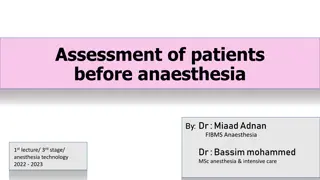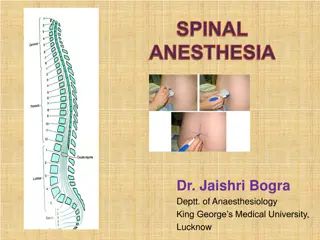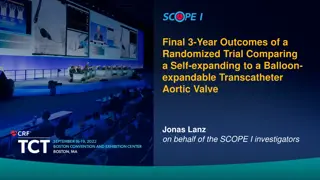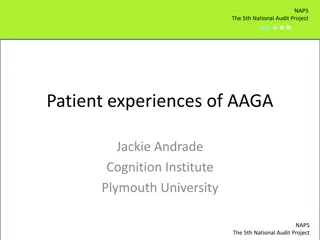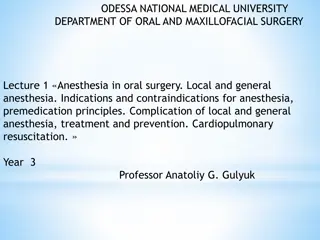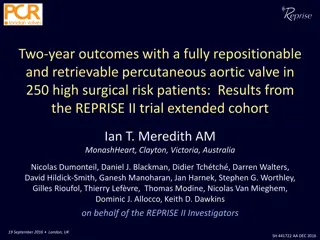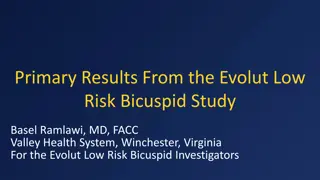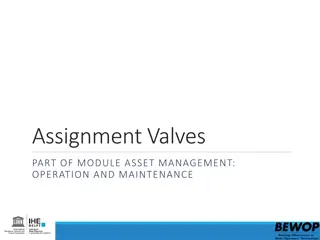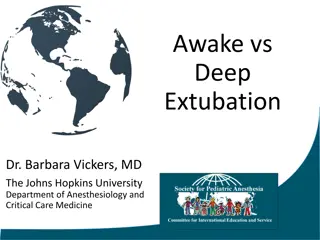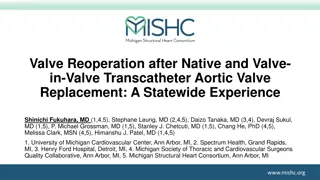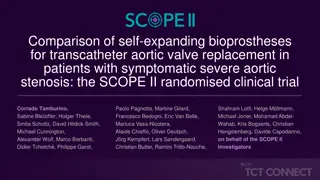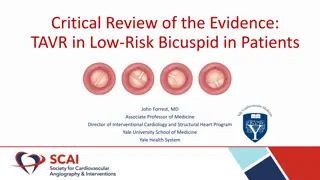Comparison of Valve Types and Anesthesia Strategies in Transcatheter Aortic Valve Implantation
In the SOLVE-TAVI trial, patients undergoing transcatheter aortic valve implantation were randomized to receive either self-expandable or balloon-expandable valves under general or local anesthesia. The study aims to compare the effectiveness and safety of different valve types and anesthesia approaches in patients with severe aortic stenosis. Primary endpoints include mortality, stroke, prosthetic valve regurgitation, and pacemaker implantation at 30 days, with various secondary endpoints assessed up to 5 years.
Download Presentation

Please find below an Image/Link to download the presentation.
The content on the website is provided AS IS for your information and personal use only. It may not be sold, licensed, or shared on other websites without obtaining consent from the author.If you encounter any issues during the download, it is possible that the publisher has removed the file from their server.
You are allowed to download the files provided on this website for personal or commercial use, subject to the condition that they are used lawfully. All files are the property of their respective owners.
The content on the website is provided AS IS for your information and personal use only. It may not be sold, licensed, or shared on other websites without obtaining consent from the author.
E N D
Presentation Transcript
SOLVE SOLVE- -TAV TAV A 2x2 Randomized Trial of Self-Expandable vs Balloon-Expandable Valves and General vs Local Anesthesia in Patients Undergoing Transcatheter Aortic Valve Implantation Holger Thiele, MD on behalf of the SOLVE-TAVI Investigators
Disclosure Statement of Financial Interest I, Holger Thiele DO NOT have a financial interest/arrangement or affiliation with one or more organizations that could be perceived as a real or apparent conflict of interest in the context of the subject of this presentation.
Background I - TAVR symptomatic patients with severe aortic stenosis at high to intermediate risk. - TAVR device design led to relevant technical and clinical improvements (e.g. pacemaker rates, paravalvular leakage, vascular complications). - There is limited evidence for direct valve comparisons (CHOICE, REPRISE III)in particular for latest generation valve designs. is developing as standard strategy for Abdel-Wahab et al. JAMA 2014;311:1503-1514 Feldman et al. JAMA. 2018;319:27-37
Background II Anesthesia Strategy - In clinical routine TAVR is performed in 50% using general or local anesthesia with conscious sedation. - Registry data suggest a) lower mortality b) lower morbidity c) shorter ICU and hospital stay d) shorter procedure times with local anesthesia. - There is a lack of adequately powered randomized trials. Villablanca et al. Catheter Cardiovasc Interv. 2017;1 13
SOLVE-TAVI Program Symptomatic Aortic Stenosis with TAVR Indication 1:1 CoreValve Evolut R Edwards Sapien 3 Valve Strategy 1:1 General Anesthesia Local Anesthesia Anesthesia Strategy
Hypotheses I) Self-expanding CoreValve Evolut R is equivalent to balloon-expandable Sapien 3 (Edwards) valve II) Local anesthesia with conscious sedation is equivalent to general anesthesia in symptomatic aortic stenosis patients undergoing transfemoral TAVR.
Endpoints Valve Strategy Primary Study Endpoint: 30-day composite of all-cause mortality, stroke, moderate or severe prosthetic valve regurgitation, and permanent pacemaker implantation. Secondary Study Endpoints: Individual components of the primary endpoint at 30 days, 6 and 12 months, 2 and 5 years Device success (VARC-2 criteria*) Early safety at 30 days (VARC-2 criteria*) Clinical efficacy at 30 days (VARC-2 criteria*) Time-related valve safety (VARC-2 criteria*) Cardiovascular mortality at 30 days, 6 and 12 months, 2 and 5 years Mean length of primary hospital stay Quality of life according to the EuroQuol-5 questionnaire (EQ-5D) at 30 days, 6 and 12 months, 2 and 5 years Device time Total procedural time *Kappetein et al. Eur Heart J 2012;33:2403 2418
Endpoints Anesthesia Strategy Primary Study Endpoint: 30-day composite of all-cause mortality, stroke, myocardial infarction, infection requiring antibiotic treatment, and acute kidney injury. Secondary Study Endpoints: Individual components of the primary endpoint at 30 days, 6 and 12 months, 2 and 5 years Postinterventional occurrence of acute delirium assessed according to CAM-ICU criteria Device time Total procedural time Need and doses of vasopressors and inotropes Mean length of primary hospital stay Mean length of primary stay at the ICU Moderate or severe moderate or severe prosthetic valve regurgitation at 30 days Cardiovascular mortality at 30 days, 6 and 12 months, 2 and 5 years Quality of life according to the EQ-5D-questionnaire at 30 days, 6 and 12 months, 2 and 5 years
Methodology Sample Size Valve Strategy - Equivalence Testing Postulated event rate for both valves 15% Lower limit - Upper limit + Equivalence zone + + -100 -90 -80 -70 -60 -50 -40 -30 -20 -10 0 10 20 30 40 50 60 70 80 90 100 Anesthesia Strategy - Equivalence Testing Postulated event rate for both anesthesia strategies 13% Lower limit - Upper limit + Equivalence zone + + -100 -90 -80 -70 -60 -50 -40 -30 -20 -10 0 10 20 30 40 50 60 70 80 90 100 Sample Size: Valve strategy: 2-sided test Chi2-test; power: 90%, =0.05 for final analysis 438 patients Anesthesia strategy: 2-sided test Chi2-test; power: 80%, =0.05 for final analysis 388 patients To compensate losses in follow-up 444 patients
SOLVE-TAVI Trial Investigator-initiated German multicenter trial; 1:1 randomization PI: Holger Thiele Rostock L beck Kiel Funding: Study Coordination: Suzanne de Waha-Thiele Bremen University Heart Center L beck: Thomas Kurz, Roza Meyer-Saraei Ingo Eitel, Matthias Heringlake Klinikum Links der Weser Bremen: Rainer Hambrecht, Harm Wienbergen Heart Center Leipzig: Hans-Josef Feistritzer, Steffen Desch Marcus Sandri, Mohamed Abdel-Wahab David Holzhey, Michael Borger Yvonne R ckert, J rg Ender University of Giessen: Holger Nef, Oliver D rr Charit Berlin: Alexander Lauten, Sascha Treskatsch University of Rostock: H seyin Ince, Mohamed Sherif University Schleswig-Holstein, Campus Kiel: Norbert Frey, Derk Frank Berlin CROs: Leipzig Giessen
Study Flow Chart - Valve Strategy 447 randomized Allocation 225 randomized to Evolut R 4 withdrawal of informed consent 1 death prior to TAVI procedure 1 medical treatment (no aortic stenosis) 222 randomized to Sapien 3 2 withdrawal of informed consent 1 death prior to TAVI procedure Intervention 219 undergoing TAVI procedure 216 Evolut R as allocated 1 cross-over Sapien 3 1 conventional AVR 1 balloon valvuloplasty only 219 undergoing TAVI procedure 218 Sapien 3 as allocated 1 cross-over Corevalve Evolut R Follow-up 219 eligible for 30-day follow-up 2 missing data for primary endpoint 219 eligible for 30-day follow-up 1 withdrawal of informed consent 3 missing data for primary endpoint Primary endpoint analysis 215 primary endpoint analysis 217 primary endpoint analysis
Baseline Characteristics Valve Strategy Characteristic Evolut R (n=219) 81.7 5.3 105/219 (47.9) Sapien 3 (n=219) 81.5 5.7 109/219 (49.8) Age (years); mean SD Male sex; n/total (%) Risk scores STS score (%); mean SD Log. EuroScore I (%), mean SD EuroScore II (%), mean SD Frailty; n/total (%) Peripheral arterial disease; n/total (%) Prior myocardial infarction; n/total (%) Prior PCI; n/total (%) Prior CABG; n/total (%) Atrial fibrillation; n/total (%) Pacemaker/ICD; n/total (%) Prior stroke; n/total (%) Renal insufficiency; n/total (%) Pulmonary hypertension; n/total (%) COPD; n/total (%) Cardiovascular risk factors Diabetes; n/total (%) Arterial hypertension; n/total (%) HLP; n/total (%) Current smoking; n/total (%) 7.7 7.2 18.4 12.1 6.1 5.5 93/216 (43.1) 28/219 (12.8) 19/219 (8.7) 84/219 (38.4) 26/219 (11.9) 103/219 (47.0) 24/218 (11.0) 25/219 (11.4) 177/216 (81.9) 106/216 (49.1) 30/219 (13.7) 7.6 7.4 18.3 13.1 5.4 4.9 80/217 (36.9) 27/219 (12.3) 22/219 (10.1) 79/219 (36.1) 18/219 (8.2) 93/219 (42.5) 23/219 (10.5) 26/218 (11.9) 184/214 (86.0) 105/218 (48.2) 29/217 (13.4) 79/218 (36.2) 193/219 (88.1) 118/218 (54.1) 8/218 (3.7) 68/219 (31.1) 204/219 (93.2) 80/217 (36.9) 10/219 (4.6)
Treatment Valve Strategy Characteristic Evolut R (n=219) Sapien 3 (n=219) P Pre echo data AVA; cm2 AVA index; cm2/m2 Mean gradient; mmHg Peak gradient; mmHg TAPSE; mm LVEF >55%; n/total (%) LVEF 45-54%; n/total (%) LVEF 35-44%; n/total (%) LVEF <35%; n/total (%) Valve size 23 mm; n/total (%) 26 mm; n/total (%) 29 mm; n/total (%) 34 mm; n/total (%) Pre dilatation; n/total (%) Post dilatation; n/total (%) Recapturing; n/total (%) Contrast agent, ml Fluoroscopy time, min 0.76 0.19 0.41 0.12 39.5 14.4 63.9 22.9 20.6 4.6 114/203 (56.2) 56/203 (27.6) 21/203 (10.3) 12/203 (5.9) 0.77 0.20 0.43 0.12 39.5 14.4 64.2 26.4 19.9 5.7 114/201 (56.7) 52/201 (25.9) 16/201 (8.0) 19/201 (9.5) 0.60 0.39 0.39 0.52 0.37 0.49 1/215 (0.5) 56/215 (26.2) 108/215 (50.2) 50/215 (23.3) 83/219 (37.9) 77/219 (35.2) 55/204 (27.0) 119 44 14.2 12.8 51/218 (23.4) 120/218 (55.1) 47/218 (21.6) 86/216 (39.8) 50/218 (22.9) 0 98 33 12.0 6.1 0.68 0.006 <0.001 <0.001 0.02
Primary Endpoint Valve Strategy All-cause mortality, stroke, moderate or severe prosthetic valve regurgitation, permanent pacemaker implantation at 30 days Rate difference -1.14 90%CI -8.15 5.87 Pequivalence=0.02 Psuperiority=0.83 50 40 27.2% 30 26.1% % 20 10 0 Evolut R Sapien 3
Endpoints Valve Strategy Individual components primary endpoint 50 Evolut R Sapien 3 40 Pequivalence=0.06 Psuperiority=0.34 22.9% 30 % 19.0% 20 Pequivalence<0.001 Psuperiority=0.77 Pequivalence=0.003 Psuperiority=0.01 Pequivalence<0.001 Psuperiority>0.99 1.9% 10 4.7% 2.8% 2.3% 1.4% 0.5% 0 Valve Moderate/severe valve regurgitation Pacemaker Mortality Stroke Pacemaker implantation implantation Mortality Stroke regurgitation
Secondary Endpoints Valve Strategy Evolut R (n=219) Sapien 3 (n=219) Rate difference Pequivalence Psuperiority Device time, min 63 32 64 43 0.80 Total procedural time, min 118 48 117 52 0.40 Cardiovascular mortality, n (%) 1/216 (0.5) 4/218 (1.8) 1.37 (-2.27 5.01) <0.001 0.37 Hospital stay, days 9 7 9 7 0.97 VARC-2 criteria: Device success, n (%) 203/216 (94.0) 200/218 (91.7) -2.24 (-6.91 2.43) 0.002 0.46 Early safety, n (%) 24/217 (11.1) 33/219 (15.1) 4.01 (-1.57 9.59) 0.03 0.26 Clinical efficacy, n (%) 74/216 (34.3) 80/217 (36.9) 2.61 (-4.94 10.15) 0.05 0.61 Time-related safety, n (%) 41/217 (18.9) 58/219 (26.5) 7.59 (0.91-14.27) 0.27 0.07
Subgroup Analysis Valve Strategy Primary Endpoint Event Corevalve Evolut R Sapien 3 No. of patients with event/total no. (%) Subgroup Rate difference (90% CI) P Value for Interaction Sex Female Male Age <80 years 80 years Coronary artery disease Yes No Frailty Mild Moderate Chronic renal failure Yes No Left ventricular ejection fraction <35 % 35 % Body mass index <25 kg/m 25-30 kg/m 30 kg/m STS score <10% 10% Logistic EuroScore <20% 20% Aortic stenosis Normal flow, high gradient Low flow, low gradient Paradoxical low flow low gradient ScO2 prior to intervention <50% 50% Mode of anesthesia General anesthesia Local anesthesia 28/113 (24.8) 31/104 (29.8) 33/107 (30.8) 23/108 (21.3) 6.1 (-3.9 16.0) -8.5 (-18.4 1.4) 0.08 18/69 (26.1) 41/148 (27.7) 16/73 (21.9) 40/142 (28.2) -4.2 (-16.0 7.7) 0.5 (-8.2 9.2) 0.59 34/126 (27.0) 22/80 (27.5) 34/115 (29.6) 21/94 (22.3) 2.6 (-7.0 12.2) -5.2 (-16.0 5.7) 0.37 52/202 (25.7) 4/12 (33.3) 53/204 (26.0) 3/9 (33.3) 0.2 (-6.9 7.4) 0.0 (-34.3 34.4) 0.99 49/175 (28.0) 10/39 (25.6) 46/182 (25.3) 9/28 (32.1) -2.7 (-10.4 5.0) 6.5 (-12.1 25.1) 0.44 3/12 (25.0) 52/189 (27.5) 4/19 (21.1) 47/179 (26.3) -4.0 (-30.1 22.2) -1.3 (-8.9 6.4) 0.86 25/69 (36.2) 20/95 (21.1) 13/52 (25.0) 22/76 (29.0) 22/90 (24.4) 12/49 (24.5) -7.3 (-20.1 5.5) 3.4 (-6.8 13.6) -0.5 (-14.7 13.7) 0.57 43/149 (28.9) 9/49 (18.4) 36/157 (22.9) 18/50 (36.0) -5.9 (-14.2 2.3) 17.6 (2.8 32.5) 0.02 36/142 (25.4) 22/74 (29.7) 33/141(23.4) 23/74 (31.1) -2.0 (-10.4 6.5) 1.4 (-11.1 13.8) 0.71 23/98 (23.5) 19/50 (38.0) 7/32 (21.9) 23/98 (23.5) 13/50 (26.0) 13/41 (31.7) 0.0 (-10.0 10.0) - 12.0 (-27.4 3.4) 9.8 (-7.8 27.4) 0.29 42/158 (26.6) 5/15 (33.3) 45/165 (27.3) 4/12 (33.3) 0.7 (-7.5 8.8) 0.0 (-30.2 30.2) 1.00 32/111 (28.8) 27/106 (25.5) 22/107 (20.6) 34/108 (31.5) -8.3 (-18.0 1.5) 6.0 (-4.2 16.2) 0.09 -20 -15 -10 10 15 20 -5 5 Sapien 3 better Equivalence margin Corevalve Evolut R better
Study Flow Chart - Anesthesia Strategy 447 randomized Allocation 222 randomized to local anesthesia 3 withdrawal of informed consent 1 death prior to TAVI procedure 225 randomized to general anesthesia 3 withdrawal of informed consent 1 death prior to TAVI procedure 1 medical treatment (no aortic stenosis) Intervention 218 undergoing TAVI procedure 217 local anesthesia 13 bailout general anesthesia 1 elective cross over general anesthesia 220 undergoing TAVI procedure 219 general anesthesia 1 elective cross-over to local anesthesia Follow-up 220 eligible for 30-day follow-up 218 eligible for 30-day follow-up 1 withdrawal of informed consent 2 missing data for primary endpoint Primary endpoint analysis 215 primary endpoint analysis 220 primary endpoint analysis
Baseline Characteristics Anesthesia Strategy Characteristic Local Anesthesia (n=218) 81.8 5.3 107/218 (49.1) General Anesthesia (n=220) 81.4 5.7 107/220 (48.6) Age (years); mean SD Male sex; n/total (%) Risk scores STS score (%); mean SD Log. EuroScore I (%), mean SD EuroScore II (%), mean SD Frailty; n/total (%) Peripheral arterial disease; n/total (%) Prior myocardial infarction; n/total (%) Prior PCI; n/total (%) Prior CABG; n/total (%) Atrial fibrillation; n/total (%) Pacemaker/ICD; n/total (%) Prior stroke; n/total (%) Renal insufficiency; n/total (%) Pulmonary hypertension; n/total (%) COPD; n/total (%) Cardiovascular risk factors Diabetes; n/total (%) Arterial hypertension; n/total (%) HLP; n/total (%) Current smoking; n/total (%) 6.9 6.2 17.8 12.6 5.5 4.8 91/214 (42.5) 29/218 (13.3) 24/218 (11.0) 92/218 (42.2) 22/218 (10.1) 98/218 (45.0) 13/218 (6.0) 24/217 (11.1) 179/213 (84.0) 100/216 (46.3) 27/216 (12.5) 8.3 8.2 18.9 12.5 6.0 5.6 82/219 (37.4) 26/220 (11.8) 17/220 (7.7) 71/220 (32.3) 22/220 (10.0) 98/220 (44.6) 20/220 (9.1) 27/220 (12.3) 182/217 (83.9) 111/218 (50.9) 32/220 (14.6) 70/218 (32.1) 199/218 (91.3) 92/216 (42.6) 9/218 (4.1) 77/219 (35.2) 198/220 (90.0) 88/219 (40.2) 9/219 (4.1)
Treatment Anesthesia Strategy Characteristic Local Anesthesia (n=218) 92.7 25.0 88.0 27.4 83.2 36.7 13/218 (5.9) 3/13 (23.1) 5/13 (38.5) 3/13 (23.1) 2/13 (15.4) 8/210 (3.8) General Anesthesia (n=220) 91.6 27.3 93.3 21.8 81.9 38.2 0 P O2 saturation at start of anesthesia; % Minimal O2 saturation during anesthesia; % O2 saturation at end of anesthesia; % Conversion to general anesthesia Agitation; ; n/total (%) Emergency surgery; n/total (%) Respiratory insufficiency; n/total (%) Hemodynamic reasons; n/total (%) Transesophageal echocardiography; n/total (%) Anesthesia medication Remifentanyl; n/total (%) Propofol; n/total (%) Dexmedetomidine; n/total (%) Sufentanyl; n/total (%) Fentanyl; n/total (%) Piritramide; n/total (%) Other non-benzodiazepine drugs; n/total (%) 0.08 <0.001 0.42 73/217 (33.6) <0.001 18/218 (8.3) 56/218 (25.7) 111/218 (50.9) 63/218 (28.9) 13/218 (6.0) 56/218 (25.7) 7/218 (3.2) 213/220 (96.8) 198/220 (90.0) 3/220 (1.4) 7/220 (3.2) 9/220 (4.1) 6/220 (2.7) 6/220 (2.7) <0.001 <0.001 <0.001 <0.001 0.39 <0.001 0.79
Primary Endpoint Anesthesia Strategy All-cause mortality, stroke, myocardial infarction, infection requiring antibiotic treatment, acute kidney injury at 30 days Rate difference -1.52 90%CI -8.47 5.42 Pequivalence=0.02 Psuperiority=0.74 50 40 27.0% 30 25.5% % 20 10 0 Local anesthesia General anesthesia
Endpoints Anesthesia Strategy Individual components primary endpoint 50 Local anesthesia General anesthesia 40 Pequivalence=0.005 Psuperiority>0.99 30 % 21.0% 21.0% Pequivalence<0.001 Psuperiority>0.99 8.9% 20 Pequivalence=0.002 Psuperiority>0.99 Pequivalence<0.001 Psuperiority=0.77 2.8% 2.3% Pequivalence<0.001 Psuperiority>0.99 9.2% 10 2.8% 2.4% 0.5% 0.5% 0 Mortality Mortality Acute kidney injury Stroke Myocardial infarction Myocardial infarction Infection requiring Stroke Infection requrning antibiotics antibiotics Acute kidney injury
Secondary Endpoints Anesthesia Strategy Pequivalence Psuperiority Local Anesthesia (n=218) General Anesthesia (n=220) Rate difference Cardiovascular mortality, n (%) 2/214 (0.9) 3/220 (1.4) 0.43 (-3.16 4.02) <0.001 >0.99 Moderate/severe valve regurgitation, n (%) 4/209 (1.9) 3/212 (1.4) -0.5 (-4.20 3.20) <0.001 0.72 Delirium, n (%) 28/211 (13.3) 32/215 (14.9) 1.61 (-4.13 7.36) 0.007 0.68 Device time, min 61 27 65 45 0.76 Total procedural time, min 116 50 119 49 0.43 Need for catecholamines, n (%) 137/218 (62.8) 214/220 (97.3) 34.43 (27.84 41.02) 1.00 <0.001 Hospital stay, days 9 7 9 7 0.74 ICU stay, hours 51 84 47 65 0.59
Subgroup Analysis Anesthesia Strategy Subgroup Primary Endpoint Event Rate difference (90% CI) P Value for Interaction Local anesthesia No. of patients with event/total no. (%) General anesthesia 3 Sex Female Male Age <80 years 80 years Coronary artery disease Yes No Frailty Mild Moderate Chronic renal failure Yes No Left ventricular ejection fraction <35 % 35 % Body mass index <25 kg/m 25-30 kg/m 30 kg/m STS score <10% 10% Logistic EuroScore <20% 20% Aortic stenosis Normal-flow, high-gradient Low-flow, low-gradient Paradoxical low-flow, low-gradient ScO2 prior to intervention <50% 50% Type of valve Sapien 3 Corevalve Evolut R 30/109 (27.5) 28/106 (26.4) 32/113 (28.3) 28/106 (26.4) 0.8 (-9.1 10.7) -4.0 (-13.7 5.8) 0.56 19/71 (26.8) 39/144 (27.1) 13/72 (18.1) 43/148 (29.1) -8.7 (-20.3 2.9) 2.0 (-6.7 10.6) 0.21 36/124 (29.0) 20/80 (25.0) 33/118 (28.0) 22/96 (22.9) -1.1 (-10.6 8.5) -2.1 (-12.8 8.7) 0.89 53/201 (26.4) 3/10 (30.0) 49/208 (23.6) 6/11 (54.6) -2.8 (-9.9 4.2) 24.6 (-10.9 60.0) 0.20 54/176 (30.7) 4/34 (11.8) 50/182 (27.5) 6/35 (17.1) -3.2 (-11.1 4.7) 5.4 (-9.2 20.0) 0.41 5/15 (33.3) 48/186 (25.8) 3/16 (18.8) 48/185 (26.0) -14.6 (-40.6 11.5) 0.1 (-7.4 7.6) 0.37 22/78 (28.2) 22/87 (25.3) 14/50 (28.0) 20/68 (29.4) 22/100 (22.0) 14/51 (27.5) 1.2 (-11.2 13.6) -3.3 (-13.6 7.0) -0.6 (-15.2 14.1) 0.89 44/159 (27.7) 13/42 (31.0) 37/150 (24.7) 16/57 (28.1) -3.0 (-11.3 5.3) -2.9 (-18.3 12.5) 0.97 37/147 (25.1) 21/68 (30.9) 32/138 (23.2) 24/81 (29.6) -2.0 (-10.4 6.4) -1.3 (-13.7 11.2) 0.91 30/85 (31.6) 15/49 (30.6) 7/38 (18.4) 27/103 (26.2) 15/51 (29.4) 8/35 (22.9) -5.4 (-16.0 5.2) -1.2 (-16.3 13.9) 4.4 (-11.3 20.1) 0.71 49/167 (29.3) 3/10 (30) 41/159 (25.8) 4/17 (23.5) -3.6 (-11.7 4.6) -6.5 (-36.0 23.0) 0.87 28/110 (25.5) 30/105 (28.6) 25/108 (23.2) 31/112 (27.7) -2.3 (-11.9 7.3) -0.9 (-11.0 9.2) 0.85 -20 -15 -10 10 15 20 -5 5 Local anesthesia better Equivalence margin General anesthesia better
Summary and Conclusions I In transfemoral TAVR the self-expanding Corevalve Evolut R valve is equivalent to the balloon-expandable Edwards Sapien 3 with respect to the composite of all-cause mortality, stroke, moderate or severe prosthetic valve regurgitation, and permanent pacemaker implantation at 30 days. patients with symptomatic aortic stenosis undergoing The rate of relevant valve regurgitation was low whereas permanent pacemaker rates are still relatively high. There may be a higher stroke rate with the balloon-expandable valve.
Summary and Conclusions II Local anesthesia with conscious sedation is equivalent to general anesthesia with respect to the composite of all-cause mortality, stroke, myocardial infarction, treatment, and acute kidney injury. infection requiring antibiotic General anesthesia is associated with a higher rate of catecholamine use but does not affect procedure times, valve- related outcome, or clinical outcome.
Acknowledgement and Thank You SOLVE-TAVI Patients and Investigators Steering Committee Holger Thiele, MD (Chair) Steffen Desch, MD Suzanne de Waha-Thiele, MD Thomas Kurz, MD Holger Nef, MD Rainer Hambrecht, MD Norbert Frey, MD Alexander Lauten, MD H seyin Ince, MD Michael Borger, MD David Holzhey, MD Matthias Heringlake, MD J rg Ender, MD DSMB Gerhard Schuler, MD Steffen Schneider, PhD Bernd B ttiger, MD CRO Leipzig Heart Institute: Yvonne R ckert Anne-Kathrin Funkat, PhD Ina Wagner IMBS L beck Inke K nig, PhD Reinhard Vonthein, PhD J rdis Stolpmann Funding German Heart Research Foundation ZKS L beck: Arne Schreiber, PhD Alicia Illen Echo Core lab Heart Center Leipzig:: Georg Stachel, MD Suzanne de Waha-Thiele, MD
